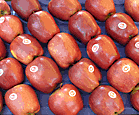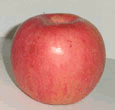Apple Fruit Nutrition Facts
Delicious and crunchy, apple fruit is one of the most popular and favorite fruits among the health conscious, fitness lovers who firmly believe in the concept of “health is wealth.” This wonderful fruit is packed with rich phyto-nutrients that, in the true sense, indispensable for optimal health. The antioxidants in apple have several health promoting and disease prevention properties, and thereby, truly justifying the adage, “an apple a day keeps the doctor away.”
Scientific name: Malus domestica.
 |
 |
 |
| Crimson-red apple. | Apples in a store. | Apple, york. (Malus domestica) |
Apples are obtained from the medium-sized tree belonging to the Rosaceae family. The apple tree is thought to be originated in the mineral-rich mountain ranges of Kazakhstan, and today, being cultivated in many parts of the world.
Apple fruit features oval or pear shape. Its outer peel has different colors depending upon the cultivar type. Internally, its crispy, juicy pulp is off-white to cream in color, and has a mix of mild sweet and tart flavor. Its seeds are bitter in taste, and therefore, inedible.
Hundreds of varieties of apples that are meant to be used either as table or dessert apples or in cooking grown in the US and worldwide. Cooking apples tend to be larger in size, crispier, and tarter than dessert types.
Health benefits of apple
- Delicious and crunchy apple fruit is notable for its impressive list of phtyto-nutrients, and anti-oxidants. Studies suggest that its components are essential for optimal growth, development, and overall wellness.
- Apples are low in calories; 100 g of fresh fruit slices provide only 50 calories. They, however, contain no saturated fats or cholesterol. Nonetheless, the fruit is rich in dietary fiber, which helps prevent absorption of dietary-LDL or bad cholesterol in the gut. The fiber also saves the colon mucous membrane from exposure to toxic substances by binding to cancer-causing chemicals inside the colon.
- Apples are rich in antioxidant phyto-nutrients flavonoids and polyphenolics. The total measured anti-oxidant strength (ORAC value) of 100 g apple fruit is 5900 TE. Some of the important flavonoids in apples are quercetin, epicatechin, and procyanidin B2. Additionally, they are also good in tartaric acid that gives tart flavor to them. Altogether, these compounds help the body protect from deleterious effects of free radicals.
- Apple fruit contains good quantities of vitamin-C and beta-carotene. Vitamin C is a powerful natural antioxidant. Consumption of foods rich in vitamin C helps the body develop resistance against infectious agents and scavenge harmful, pro-inflammatory free radicals from the body.
- Further, apple fruit is a good source of B-complex vitamins such as riboflavin, thiamin, and pyridoxine (vitamin B-6). Together, these vitamins help as co-factors for enzymes in metabolism as well as in various synthetic functions inside the body.
- Apples also carry a small amount of minerals like potassium, phosphorus, and calcium. Potassium is an important component of cell and body fluids helps controlling heart rate and blood pressure; thus, counters the bad influences of sodium.
| Energy | 50 Kcal | 2.5% |
| Carbohydrates | 13.81 g | 11% |
| Protein | 0.26 g | 0.5% |
| Total Fat | 0.17 g | 0.5% |
| Cholesterol | 0 mg | 0% |
| Dietary Fiber | 2.40 g | 6% |
| Vitamins | ||
|---|---|---|
| Folates | 3 µg | 1% |
| Niacin | 0.091 mg | 1% |
| Pantothenic acid | 0.061 mg | 1% |
| Pyridoxine | 0.041 mg | 3% |
| Riboflavin | 0.026 mg | 2% |
| Thiamin | 0.017 mg | 1% |
| Vitamin A | 54 IU | 2% |
| Vitamin C | 4.6 mg | 8% |
| Vitamin E | 0.18 mg | 1% |
| Vitamin K | 2.2 µg | 2% |
| Electrolytes | ||
| Sodium | 1 mg | 0% |
| Potassium | 107 mg | 2% |
| Minerals | ||
| Calcium | 6 mg | 0.6% |
| Iron | 0.12 mg | 1% |
| Magnesium | 5 mg | 1% |
| Phosphorus | 11 mg | 2% |
| Zinc | 0.04 mg | 0% |
| Phyto-nutrients | ||
| Carotene-ß | 27 µg | -- |
| Crypto-xanthin-ß | 11 µg | -- |
| Lutein-zeaxanthin | 29 µg | -- |
Selection and Storage
Fresh apples can be readily available in the stores all around the season. Choose fresh, bright, firm textured apples with rich flavor. Avoid fruits with pressure marks over their surface as they indicate underlying mottled pulp.
Fresh apples can be kept at room temperature for few days and stored inside the refrigerator for upto two to three weeks. Wash them in clean running cold water before use.
Preparation and Serving tips
Wash apples thoroughly in the running water to remove any surface dust, insecticide/fungicide sprays. Trim off its top end using a paring knife, and cut the fruit into two equal halves. Take out tiny, centrally placed, bitter seeds. Slice the fruit into desirable cubes or slices.
 |
 |
| Apple fruit sections. | Apples pie. Photo by: kanko |
Here are some serving tips:
- Eat apple fruit as it is along with its peel in order to get maximum health-benefits.
- Sliced apple turns brown (enzymatic brownish discoloration) on exposure to air due to conversion in iron form from ferrous oxide to ferric oxide. If you have to serve them sliced, rinse slices in water added with few drops of fresh lemon.
- Cloudy as well as clear apple juice is a healthy alternative drink with dinner.
- Apple fruit is also used in the preparation of fruit jam, pie, and fruit salads.
Safety profile
Good yield demands close attention and supervision of apple fruit crop. According to the environmental-working group reports, apple fruit is one of the heavily pesticide-contaminated produce. The most common pesticides found on apple are organo-phosphorous and organo-chloride pesticides like Permethrin and DDT. Therefore, it is recommended to wash the fruit thoroughly before use. If possible, use organic certified apples. (Medical disclaimer).



